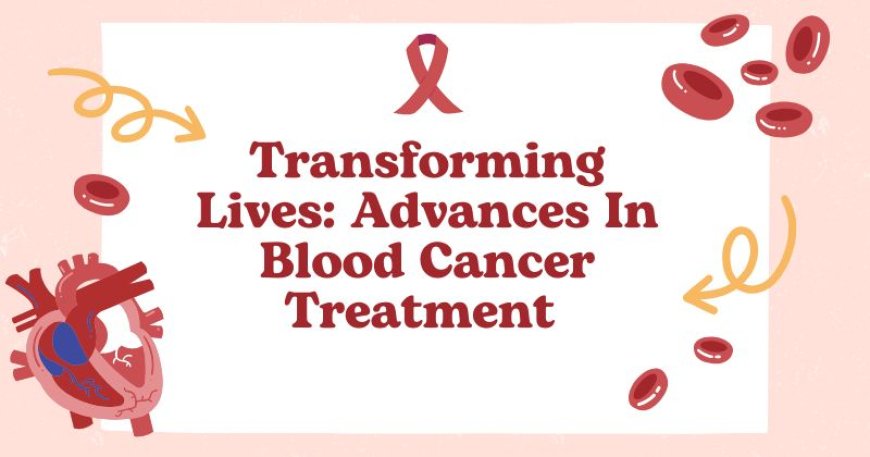Transforming Lives: Advances In Blood Cancer Treatment
Blood cancer (hematologic cancer) is the cancer that impacts the blood cells, bone marrow, and lymphatic system. Bone marrow is the primary maker of blood cells, and where these mature and carry out their tasks. For improved results and less damage, detection at an early stage and suitable cancer therapies are crucial. Patients who suffer from blood cancer have uncontrollably growing aberrant cells that cause blood cancer to interfere with normal blood processes. Some common blood cancer treatments for decreased growth of blood cancer can include oral medicines and close observation. Currently, many blood cancer treatment options are available, and these are constantly evolving with time. The patient’s preferences and the severity of the cancer will highlight the course and length of treatment. The end goal is to improve the patient’s quality of life without sacrificing or compromising on his health.

In recent years, groundbreaking progress in medical science has dramatically improved the outlook for individuals diagnosed with blood cancer. Similarly, recognizing blood cancer symptoms in child patients can be challenging. Once considered a largely untreatable condition, blood cancers like leukemia, lymphoma, and myeloma are now managed more effectively thanks to cutting-edge therapies, early detection, and personalized treatment plans. This transformation in care is not just extending lives—it’s enhancing the quality of life for thousands around the globe.
Understanding Blood Cancer
Blood cancer affects the production and function of blood cells. Most blood cancers start in the bone marrow, where blood is produced. Stem cells in the bone marrow mature and develop into three types of blood cells: red blood cells, white cells, or platelets. In people with blood cancer, the development of blood cells is disrupted, causing abnormal blood cells to grow uncontrollably.
There are three main types of blood cancer:
-
Leukemia, which affects the bone marrow and blood.
-
Lymphoma, which affects the lymphatic system.
-
Myeloma, which targets plasma cells in the bone marrow.
Each type requires specific diagnostic and therapeutic approaches, and recent advances are making these treatments more precise and effective.
Advances in Early Diagnosis
One of the most critical factors in successfully treating blood cancer is early detection. Recognizing the signs and symptoms early on can lead to a faster diagnosis and, consequently, a more favorable outcome. It’s important to understand that blood cancer symptoms in women and men may be similar, but sometimes symptoms are overlooked or attributed to less serious conditions.
Some of the blood cancer symptoms in women include:
-
Persistent fatigue
-
Unexplained weight loss
-
Frequent infections
-
Easy bruising or bleeding
-
Night sweats
Due to hormonal differences and societal factors, women might dismiss these signs as related to stress or hormonal changes. Both patients and healthcare providers must stay vigilant and consider blood cancer as a possibility when such symptoms are present.
Similarly, recognizing blood cancer symptoms in child patients can be challenging. Children may not always be able to articulate what they’re feeling, and their symptoms might mimic common childhood illnesses.
Common blood cancer symptoms in children include:
-
Constant tiredness or weakness
-
Frequent or severe infections
-
Bone or joint pain
-
Swelling in the abdomen, lymph nodes, or face
-
Unexplained fevers
Pediatricians and caregivers must be attentive to these signs and not hesitate to conduct further testing if multiple symptoms are present.
Cutting-Edge Treatments Revolutionizing Care
The field of hematology-oncology has seen significant breakthroughs in treatment options for blood cancers. These innovations are not only increasing survival rates but are also making treatment less invasive and more tailored to individual needs.
1. Targeted Therapy
Unlike traditional chemotherapy that attacks all rapidly dividing cells, targeted therapy focuses on specific genetic mutations or proteins in cancer cells. This precision reduces damage to healthy cells and results in fewer side effects. For example, drugs targeting the Philadelphia chromosome in chronic myeloid leukemia (CML) have turned what was once a fatal disease into a manageable chronic condition.
2. Immunotherapy
Immunotherapy leverages the body’s own immune system to fight cancer. CAR T-cell therapy, a type of immunotherapy, has shown remarkable success in treating certain types of leukemia and lymphoma. By reengineering a patient’s T-cells to target and destroy cancer cells, this therapy offers hope to those who have relapsed or not responded to conventional treatments.
3. Bone Marrow and Stem Cell Transplants
Stem cell transplants remain a cornerstone of treatment for many blood cancers. Advances in donor matching, conditioning regimens, and post-transplant care have significantly improved outcomes and reduced complications. For children, in particular, stem cell transplants can offer a curative option.
4. Genomic Medicine and Personalized Treatment
Today’s oncologists increasingly use genomic profiling to understand the exact mutations driving an individual’s cancer. This information allows them to craft a treatment plan specifically tailored to the patient’s cancer profile. Such personalized medicine is proving especially useful in treating rare or aggressive blood cancers.
Improving Quality of Life
Beyond prolonging survival, modern treatments are also helping patients maintain a higher quality of life during and after treatment. Supportive care innovations, such as better anti-nausea medications, growth factors to boost blood counts, and psychosocial support services, are making a profound difference in the treatment experience.
More awareness and education about early symptoms—including blood cancer symptoms in women and blood cancer symptoms in child—are empowering patients and families to seek help sooner, reducing diagnostic delays.
Looking Ahead
The future of blood cancer treatment is filled with promise. Ongoing research into epigenetics, cellular therapies, and vaccine-based treatments could revolutionize care even further. Clinical trials continue to open doors to new possibilities for those affected.
Meanwhile, raising awareness about the disease and its early warning signs remains a critical component of fighting blood cancer. Whether it's understanding blood cancer symptoms in women or being alert to blood cancer symptoms in children, knowledge truly is power.
Conclusion
The transformation in blood cancer treatment over the past decade is nothing short of remarkable. With earlier detection, smarter therapies, and more personalized care strategies, lives are not just being saved but profoundly improved. Continued research, patient education, and access to care will ensure even more success stories in the years to come.
Let us continue to support innovation and spread awareness, because every step forward is a step toward a world where blood cancer is no longer a life-threatening diagnosis but a manageable condition.
For More:- (Click Here)






























































































































































